Every second family in India houses a patient who is already suffering from Arthritis; or perhaps prone to this condition. Arthritis – a disease that greatly challenges your mobility, has been around for years as one of the major causes of disability amongst people.
Over the years, arthritis has been thought to be a medical condition afflicting older generations alone. And perhaps it would not be wrong to say that this perception, although not fully correct, still exists among the Indian population.
However, it may come up as a shocking revelation for many to know, that arthritis could affect children below the age of 16 years or even lesser!
Arthritis is a musculoskeletal disorder involving inflammation of one or more joints in the body. Depending on the type of joint disease and reasons causing it, there are around hundred different forms of arthritis.
Identifying Arthritis symptoms early and opting for correct remedial measures prevents this disease from getting severe and therefore does not hinder with your day to day activities.
However, arthritis does not show visible symptoms early. Therefore, having sufficient idea about early symptoms and measures of treatment can help to control arthritis to a great extent. Thus, facilitating normal and regular activities even when you are living with this problem.
This post could help you get an overall idea about different types of arthritis and symptoms related. You could also know about treatment options and preventive measures.
What is the pain like?
All of us experience slight pain and joint aches at some point of our life. With age, these discomforts become more common. However, not every one experiencing pain is said to suffer from this severe condition of arthritis.
Arthritis pain and discomfort involves stiffness around the joints along with persistent pain. Besides, different types of arthritis (discussed later) have specific feeling of discomfort.
Some patients may complain of severe pain only during the second half of the day; while there’s no pain during early mornings. Again, some may experience sharp pain and burning sensations.
Arthritis diagnosis and treatment greatly depends on how well you explain your feelings to doctors. Therefore, to aide you with this, we have provided a list of symptoms associated with each type of arthritis.
Different types of arthritis and associated symptoms:
Although there are around 100 different types of arthritis, this post includes the most common types prevalent in India.
The most common types of arthritis are:
- Osteoarthritis
- Rheumatoid Arthritis
- Gout
- Septic Arthritis
- Psoriatic Arthritis
- Reactive Arthritis
- Juvenile Idiopathic Arthritis
Osteoarthritis:
Osteoarthritis is the most common types of arthritis resulting from damaged cartilages. Osteoarthritis is more common with joints that bear weight; such as, knees, spine, hip and feet. Every two bones, forming a joint, are cushioned with rubbery tissues known as cartilages. Any wear and tear of this cartilage results in osteoarthritis.
Causes:
- With age our bones and cartilages get worn out
- Obesity that puts on excessive pressure on bones and cartilages that constitute joints bearing weight
- Certain bone injury
- Family history of osteoarthritis makes you prone to this condition, especially when proper preventive measures are not adopted
- People involved in some kind of physical activities that require excessive use of joints are prone to knee osteoarthritis
Symptoms:
- Morning stiffness or experiencing the same after long periods of rest
- Pain felt deep within the bones
- Joint pain getting severe with later part of the day
- You can sense swelling of joints
- Your joints may feel a little warm
- A grating sound resulting from roughened and worn out cartilages that rub against each other
- Difficulty in climbing stairs, combing hair, bending over, etc. In short, you may experience hindered motion
- Numbing and tingling of the affected area. This condition is more common with spine osteoarthritis
- Bony spurs or bone enlargement on fingers
- Formation of Bunions on big toes. It is a kind of bony enlargement peculiar to toes.
Rheumatoid Arthritis:
Rheumatoid Arthritis is a type of autoimmune arthritis that is caused by a disorder associated with the immune system. The body’s own immune system attacks joints leading to worn out tissues. Rheumatoid arthritis is experienced mostly with small joints; such as knuckles and wrists.
Causes:
Specific triggers of this condition are yet to be determined. However, there are some probable reasons that may lead to a confused state of your immune system, where it generates antibodies to attack joints; thus leading to Rheumatoid arthritis. This condition may also affect other organs of the body and hence referred to as Rheumatoid disease.
- Genetic history of Rheumatoid arthritis
- A virus or bacteria that may interrupt with normal functioning of your immune system
- Some say that excessive smoking may even lead to this condition
- Obesity may make you susceptible to this condition
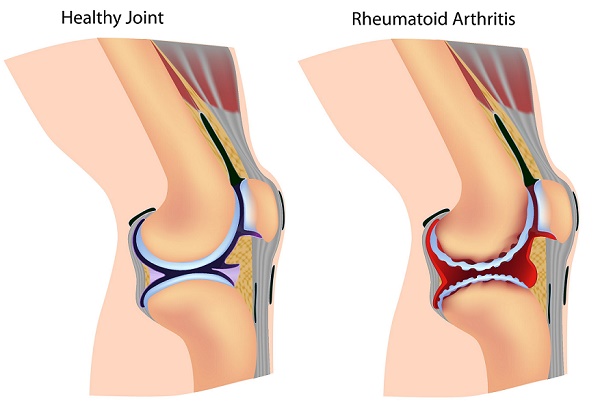
Symptoms:
- A symmetrical pattern of discomfort. This means pain or stiffness experienced with both wrists, both hips or both feet. This is what differentiates it from other forms of arthritis.
- Extreme fatigue or a continuous feeling of tiredness
- Abrupt weight loss and lack of appetite
- Morning stiffness experienced for several hours for some people
- Fluid accumulation within joints result in swelling
- Joints become sensitive and tender
- Your joints appear red and warm
- Shortness of breadth when condition affects lungs
- Chest pain and breathing trouble when heart is affected
- Hoarseness in rare cases
Gout:
A condition resulting from excess uric acid in blood, that may lead to formation of crystals within joints. Unlike other forms of arthritis that are more common with women, men are more prone to Gout. You may develop Gout in your big toe, ankle, feet and knees. Besides, they may appear on any other joint of our body as well.
Causes:
- High blood pressure and diabetes
- Suffering from high uric acid for long duration
- Kidney disorders wherein they don’t filter out excess uric acid in blood
- High levels of fat and cholesterol
- Obesity
- Excessive consumption of alcohol
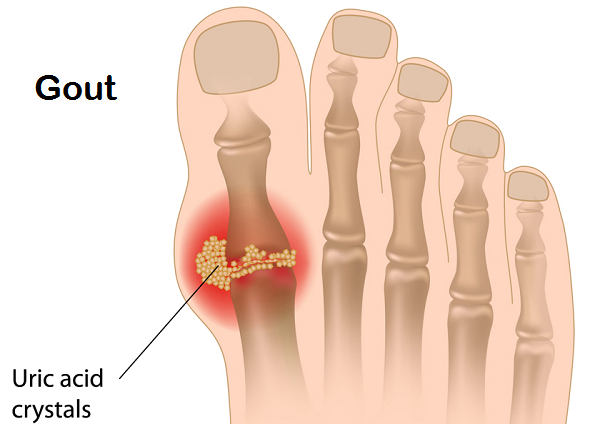
Symptoms:
Gout symptoms show up within few hours and last for around 10 days, after which they disappear. They return in an intensified form after a short duration.
- Severe pain around the joint mostly during nights
- The symptoms come and go. This is what differentiates it from other forms of arthritis.
- Hot and tender joints to an extent that it becomes difficult to touch it gently
- Visible swelling and redness
- Shiny skin over the affected joint
- Itchy skin once the swelling disappears
- Menopause makes women susceptible to Gout
Septic Arthritis:
Septic Arthritis is also known as Infectious Arthritis as it is caused by bacteria or fungus. Septic Arthritis is mostly experienced in one large and single joint in the body; such as, knee or hip. There have been very limited cases of multiple septic arthritis affecting more than one joint in the body. Youngsters and children may develop Septic Arthritis.
Causes:
- An invasion of bacteria within the body
- Bacterial infection post surgery. Knee surgeries are associated with this condition.
- Hemophilias influenza in adults and children leads to septic arthritis
- Hepatitis A, B and C can bring you at advanced risk of developing septic arthritis
- Mumps in children may lead to Septic Arthritis
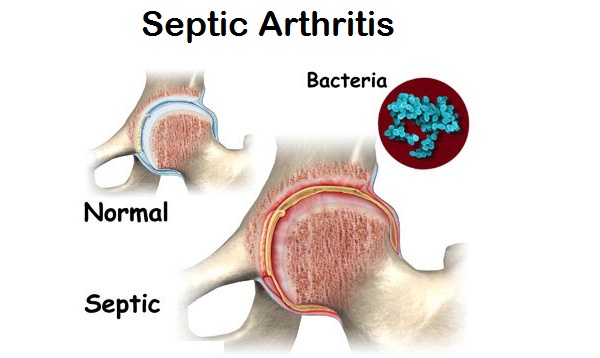
Symptoms:
- Fatigue and Weakness
- Fever and flu like symptoms
- Redness, tenderness and severe pain around the joint
- Excessive swelling due to fluid accumulation
- Inability to move the body part affected with arthritis
Psoriatic Arthritis:
People suffering from psoriasis are more likely to develop psoriatic arthritis. Psoriasis is a skin disease that results in red, itch and patchy skin. This is also a type of autoimmune arthritis similar to rheumatoid.
Anyone between age group 15 to 35 years may develop this condition. Psoriatic arthritis affects different joints – small or large. Depending on the location where it is experienced, psoriatic arthritis is of various types. Spondylitis is one of the most common forms of psoriatic arthritis.
Causes:
- Skin infection or excessive scratching
- Bad sunburn may cause psoriasis, that may eventually lead to psoriatic arthritis
- Several drugs, such as those used to treat malaria, and heart disorders etc.
- Emotional stress and anxiety aggravates psoriasis
- Smoking and alcohol consumption
- Puberty and Menopause affect hormonal levels and thus psoriasis, leading to arthritis
- Certain fungal and bacterial infection
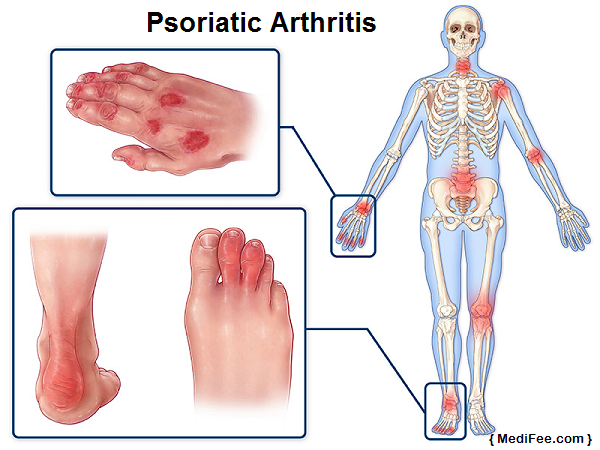
Symptoms:
- Typical symptoms fluctuate as they sometimes appear to improve and disappear only to re-appear within a short duration
- Swelling that may lead to deformities of fingers and toes
- Severe pain experienced on lower back
- Pain on the sole of your feet
- Pain and stiffness around the joints
- Conjunctivitis
- Nail Pitting
- Hindered movement
Reactive Arthritis:
Reactive arthritis is also an autoimmune condition. It develops when the body responds to some other infection affecting another part of the body; such as, urinary tract or intestines. Men, between ages 20 to 50 years are more likely to suffer from this type of arthritis. The disease affects toes, back, knees and ankles.
Causes:
- Family history
- Genital or bowel infection. Chlamydia Trachomatis is the most common.
- People tested with HLA B27 are said to develop reactive arthritis
Symptoms:
- Pain and stiffness experienced on your heels, ankles, feet lower back and buttocks
- Conjunctivitis is also considered as a symptom of reactive arthritis
- Excessive swelling of toes and fingers
- Frequent urination or difficulty while urinating
- Prostatitis in men and vulvovaginitis in women
Juvenile Idiopathic Arthritis:
Rheumatoid arthritis in children is known as juvenile rheumatoid or juvenile idiopathic arthritis. Causes and symptoms are similar to rheumatoid disease explained earlier. However, some of the symptoms commonly observed in children have been listed below.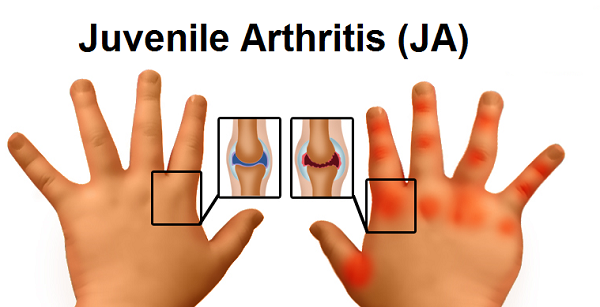
Symptoms:
- Children with this ailment may develop vision troubles. Delayed diagnosis and treatment may lead to permanent vision problems or blindness.
- Children who have learned to walk may again start crawling when affected with this arthritis
- Limping is a common and visible symptom of this disease
- Fever and flu like symptoms
- Painful and swollen joints
- Retarded growth and slow rate of development
Diagnosing – Types of Arthritis:
- Primarily, accurate diagnosis of arthritis depends on how well you explain your symptoms to your doctors. Therefore, the first method of diagnosis is a clinical discussion and physical exam.
- Doctors order X rays/CT scans and/or MRI to distinguish between types of arthritis
- Blood tests are also carried out for the same purpose
- Synovial fluid analysis is also commonly performed. It is a process where fluids, that result in swelling around joints are drawn out for laboratory testing
- Your doctor may even order for a urine test or biopsy
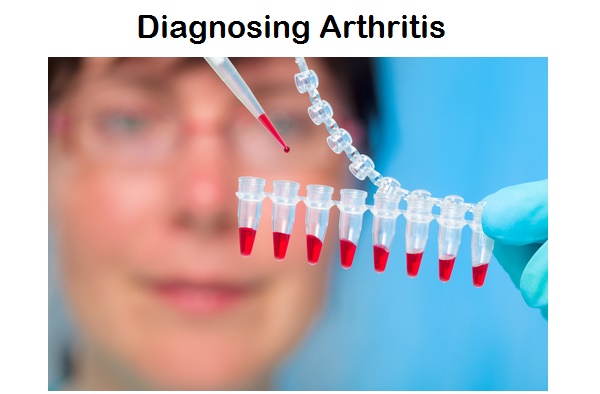
What can you do to prevent arthritis?
Family history resulting in arthritis cannot be treated completely. However, you can take up ways that can keep it under control so that you can lead normal lives. Below mentioned are some of the preventive measures for arthritis. Some of these could help you fight arthritis:
- Physical exercise is important
- Healthy diet including fish and other ingredients rich in omega 3 fatty acid
- Controlling weight
- Following correct postures; especially while lifting heavy objects
- Controlled alcohol consumption and smoking
- Visiting doctors immediately when you experience slightest of symptoms as mentioned above
- Healthy calcium intake; especially for women
- Do not neglect injuries
Arthritis is an ailment that cannot be cured completely. However, early detection and treatment procedures can help to keep this under control.
This was all about arthritis – types, symptoms, causes and things you could do to prevent it.
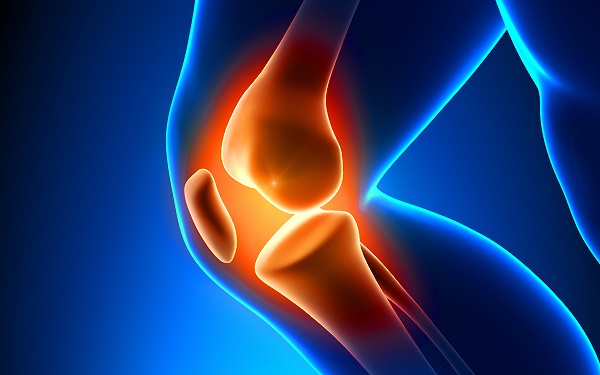
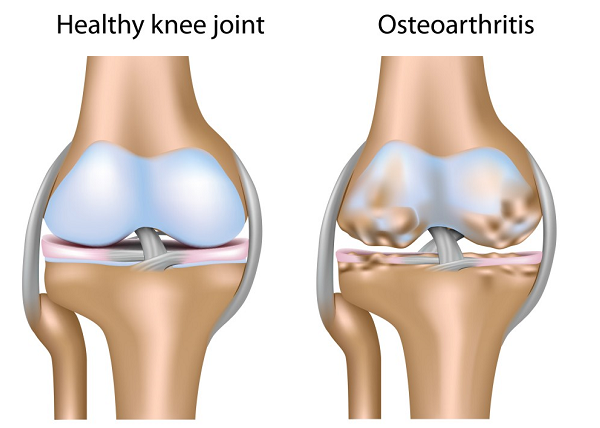
2 thoughts on “Caring For Your Joints – Understanding Arthritis”